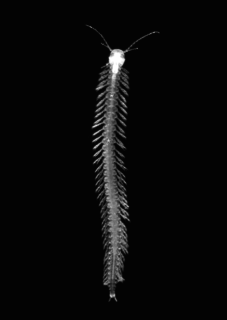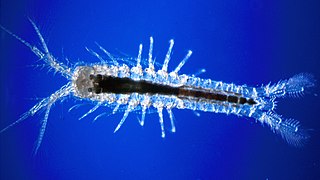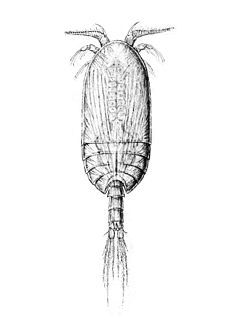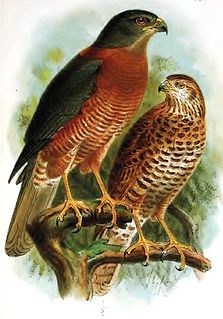Related Research Articles

Christmas Island, officially known as the Territory of Christmas Island, is an Australian external territory comprising the island of the same name. It is located in the Indian Ocean, around 350 kilometres (220 mi) south of Java and Sumatra and around 1,550 km (960 mi) north-west of the closest point on the Australian mainland. It lies 2,600 km (1,600 mi) northwest of Perth and 1,327 km (825 mi) south of Singapore. It has an area of 135 square kilometres (52 sq mi).

Remipedia is a class of blind crustaceans found in coastal aquifers which contain saline groundwater, with populations identified in almost every ocean basin so far explored, including in Australia, the Caribbean Sea, and the Atlantic Ocean. The first described remipede was the fossil Tesnusocaris goldichi. Since 1979, at least seventeen living species have been identified in subtropical regions around the world.

An anchialine pool or pond is a landlocked body of water with a subterranean connection to the ocean. Anchialine pools are a feature of coastal aquifers which are density stratified, with the water near the surface being fresh or brackish, and saline water intruding from the coast below at some depth. Depending on the site, it is sometimes possible to access the deeper saline water directly in the anchialine pool, or sometimes it may be accessible by cave diving.

Tuerkayana hirtipes is a species of terrestrial crab.

Halocaridina rubra, the Hawaiian red shrimp or volcano shrimp is a small red shrimp of the family Atyidae, with the common Hawaiian name ʻōpaeʻula.
Barbouria is a genus of shrimp in the family Barbouriidae, comprising two species.

Mictocaris halope is the only species of cave crustacean in the monotypic genus Mictocaris. It is placed in its own family, Mictocarididae, and is sometimes considered the only member of the order Mictacea. Mictocaris is endemic to anchialine caves in Bermuda, and grows up to 3.5 mm (0.14 in) long. Its biology is poorly known.

Procaris is a genus of shrimp in the family Procarididae. It contains the following species:
Parhippolyte sterreri is a species of marine decapod crustacean in the family Barbouriidae, formerly placed in the genus Somersiella. It is found in marine caves around the Bahamas, Cuba and Mexico and inland anchialine caves in Bermuda.

Typhlatya is a genus of shrimp in the family Atyidae. These are small, stygobitic shrimp found in the West Mediterranean region, Caribbean region, Ascension Island and the Galápagos, although the individual species often have very small ranges. Species in this genus are found in salt, brackish and fresh waters, mostly in anchialine habitats and none in the open sea.
Periclimenes dardanicola is a species of shrimp found in the western Pacific Ocean. It lives in association with sea anemones that live on the gastropod shells carried by hermit crabs. It was first named by Alexander J. Bruce and Junji Okuno in 2006. It is mainly white, and grows up to a carapace length of 4 mm (0.16 in).
Karstarma is a genus of karst-dwelling crabs formerly included in Sesarmoides.

Platycopiidae is a family of copepods. Until the description of Nanocopia in 1988, it contained the single genus Platycopia. It now contains four genera, three of which are monotypic; the exception is Platycopia, with 8 species.
Macromaxillocaris bahamaensis is a species of stenopodidean shrimp, the only species in the family Macromaxillocarididae. It is a troglobite, known only from an anchialine pool in a cave in the Bahamas. It differs from other stenopodideans by the enlargement of its third maxilliped.
Procaris hawaiana is a species of shrimp in the family Procarididae, from Maui, Hawaii. The species is very similar to Procaris ascensionis from Ascension Island. In P. ascensionis the integument is less firm, the rostrum is shorter, the cervical groove is more distinct, and the third abdominal somite reaches less far posteriorly over the fourth; also the scaphocerite has the final tooth still less distinct than in P. hawaiana, and the last segment of its antennal peduncle is less slender.
Calliasmata pholidota is a shrimp of the family Hippolytidae. It is thought C. pholidota is an opportunistic feeder, taking live prey or scavenging for food.
Parhippolyte is a genus of cave dwelling decapod crustaceans, known as cave shrimps from the family Barbouriidae The type species Parhipplyte uvea was described in 1900 by the English carcinologist Lancelot Alexander Borradaile from specimens collected in the south western Pacific by Arthur Willey. As their vernacular name of cave shrimp suggests these species are generally found in marine caves as well as anchialine ponds and lagoons.
Parhippolyte uveae, the sugar cane shrimp, is a species of cave shrimp from the family Barbouriidae from the Indian and western Pacific Oceans. It was described by the English carcinologist Lancelot Alexander Borradaile from specimens collected by Arthur Willey in the south Pacific in 1895–1897 and is the type species of the genus Parhippolyte.

The wildlife of Christmas Island is composed of the flora and fauna of this isolated island in the tropical Indian Ocean. Christmas Island is the summit plateau of an underwater volcano. It is mostly clad in tropical rainforest and has karst, cliffs, wetlands, coasts and sea. It is a small island with a land area of 135 km2 (52 sq mi), 63% of which has been declared a National park. Most of the rainforest remains intact and supports a large range of endemic species of animals and plants.

Periclimenes, commonly known as glass shrimp or cleaner shrimp, is a commensal and often symbiotic genus of semi-transparent shrimp within the family Palaemonidae. Species of this large genus feature a wide variety of coloration and patterns, widespread distribution throughout much of the world's tropical oceans, and are often sought out for aquarium trade.
References
- ↑ De Grave, Sammy (2010). "Procaris noelensis Bruce & Davie, 2006". WoRMS. World Register of Marine Species . Retrieved 11 December 2019.
- 1 2 3 Bruce, A.J.; Davie, Peter (2006). "A New Anchialine Shrimp Of The Genus Procaris From Christmas Island: The First Occurrence Of The Procarididae In The Indian Ocean (Crustacea: Decapoda: Caridea)". Zootaxa. 1238. doi:10.5281/zenodo.172828.
- ↑ Woinarski, John (2018). A Bat's End: The Christmas Island Pipistrelle and Extinction in Australia. Csiro Publishing. p. 43. ISBN 978-1-4863-0865-1.